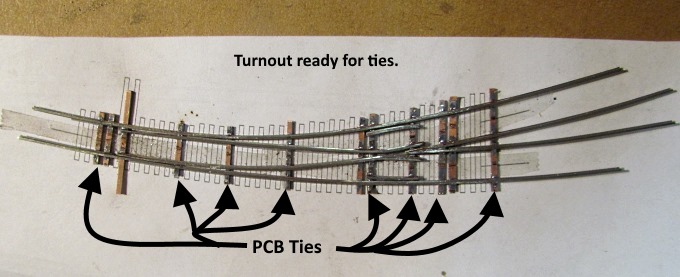
.................................. Return to Sumner's Home Page....
Return to N Scale RR Main Menu.............. Return to Trackwork Menu
=========================================
..............Previous Page..............................Next Page If There Is One
=========================================
................. --- Making N Scale PCB Ties ---
When I started making my own turnouts I started with Fast Tracks PCB (printed circuit board) ties and really like them for their ease of use. I also bought their TieBreaker Tool which makes it easy to cut the ties to the correct length for a turnout, although the tool only works for the one size turnout that you have ordered it for. Still for other turnouts you can easily cut the ties to length using a track cutter.
The PCB ties are the ones that the rails are soldered to and are basically the foundation for the turnout. Being retired and frugal I wondered if I could make my own PCB ties from printed circuit board material which you can fine pretty cheap.
I found and started using double sided printed circuit board as shown above that measures .031 in thickness, the same as the Fast-Tracks PCB ties. It is very inexpensive. I cut the ties and shaped them as shown on this page with no problem. I'd look for .031 printed circuit board as there are different thicknesses available. You will find double sided in .030 easier and if you don't see the .031 the .030 is fine. It is only .001” off.
I've had good luck with abcfab on eBay ( HERE ). As I write this 12-31-22 he has 8 pieces of .030” that are 3” x 4” For $8.00 and free shipping. That is a lot of ties for $8.00.
It that link isn't current and doesn't work search for “ Double Sided Copper Clad Circuit Board Laminate 4” x6” FR-4, .030, 3oz “.
The thickness is important if you want the ties to lay in the bottom of their fixtures with the rails on top of them. I put some of the cut PCB ties into my Fast Tracks fixture and soldered a couple pieces of rail to them and they worked just fine and the short rail section feels strong.
Remember the thickness quoted above is for N-Scale turnouts using Fast Tracks fixtures or making turnouts on paper templates. If you aren't using the fixtures then thickness isn't as importance but you would still want them no thicker than the ties you will be using and it is better if the throw-bar is thinner than the ties and is also made from printed circuit board material. For scales other than N Scale pick your printed circuit board material with a thickness that is correct for your gauge. Maybe get a small piece and see how it cuts with tin snips before ordering more.
If the board comes with some kind of coating on it (most won't) it rubs off quickly with a Scotchbrite pad. If it has the coating you want to do this before cutting the ties. As I cut the ties to length for the turnout and gap them I'll take a couple swipes at the flat surface with a file and that cleans and roughens them up for better solder adhesion.
I'd take my small square and scribe a line across the board with a pen. I had a wood tie nearby for a gauge but you quickly start drawing the lines by sight. I'd draw only one line at a time (see video below).
Then I would take tin snips and cut along the line. The board cuts really easy and with a good line it is easy to make a straight cut. After each cut I take my file and cleanup and square up the edge of the board I'm cutting from. The video below shows that this is a quick step and helps to keep the ties the same width.
The video above and ( HERE ) shows how quick and easy it is to cut and straighten the ties by hand.
Above is a picture of straightening a curled PCB tie. To straighten the tie work on the edge of a flat surface with a sharp edge and start with one half of the tie. Hold it down with one hand and using a pair of curved needle-nose pliers twist the tie straight working from the middle out to one end. Move the tie in on the flat surface as you twist it. Then turn the tie around and repeat out to the other end. A YouTube video of the process is ( HERE ) and next where you see that it only takes a few seconds to straighten the tie out.
I'm able to do enough ties for a turnout from marking and cutting them to bending them straight in 4-5 minutes.
Above are some ties before and after being straightened. The ties aren't all going to be perfect but neither are the ones in the 'real world'. If I get one that I don't like I throw it away. The cost to do that is way less than a penny.
If you end up with any ties that are a little too wide or narrow for the fixture if you are using one save them and either use them on the ends of the turnout, where I like to double up on the PCB ties for strength, or use them on a turnout that you are making using a paper template.
If you feel this isn't for you then spend a little more and order the Fast Tracks PCB ties as they are a good product.
=========================================
Was about out of ties the other day (03-10-23) so....
… spent an hour listening to music and made a batch of ties. Nice to be able to make them anytime you need some.
=========================================
...........................On..............e.........Next Page If There Is One